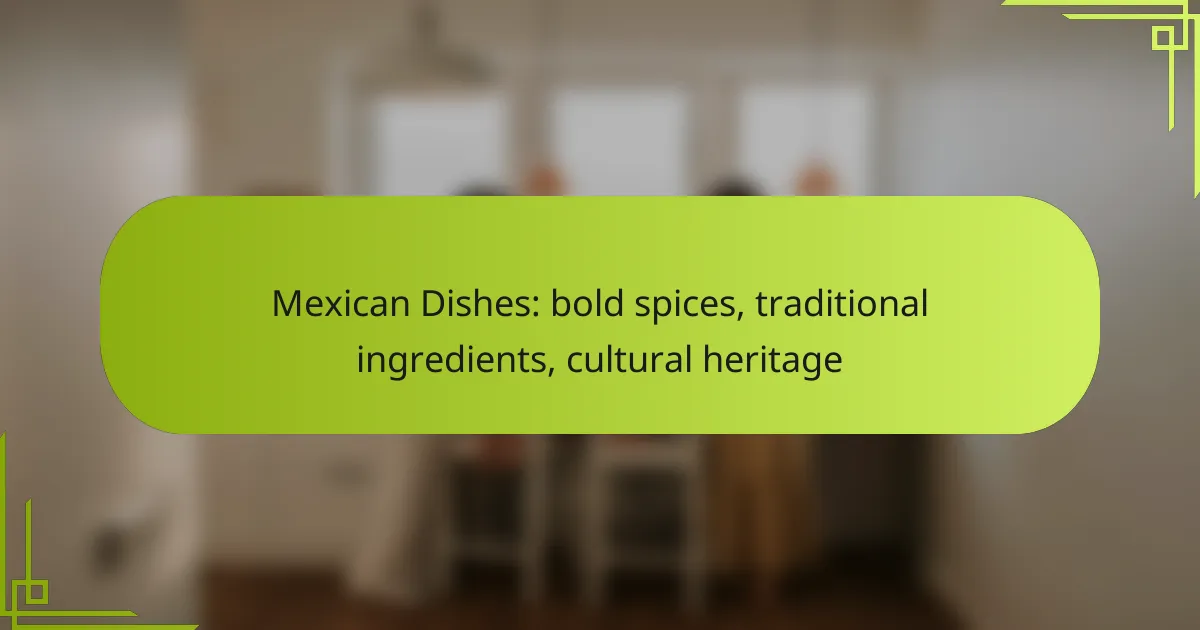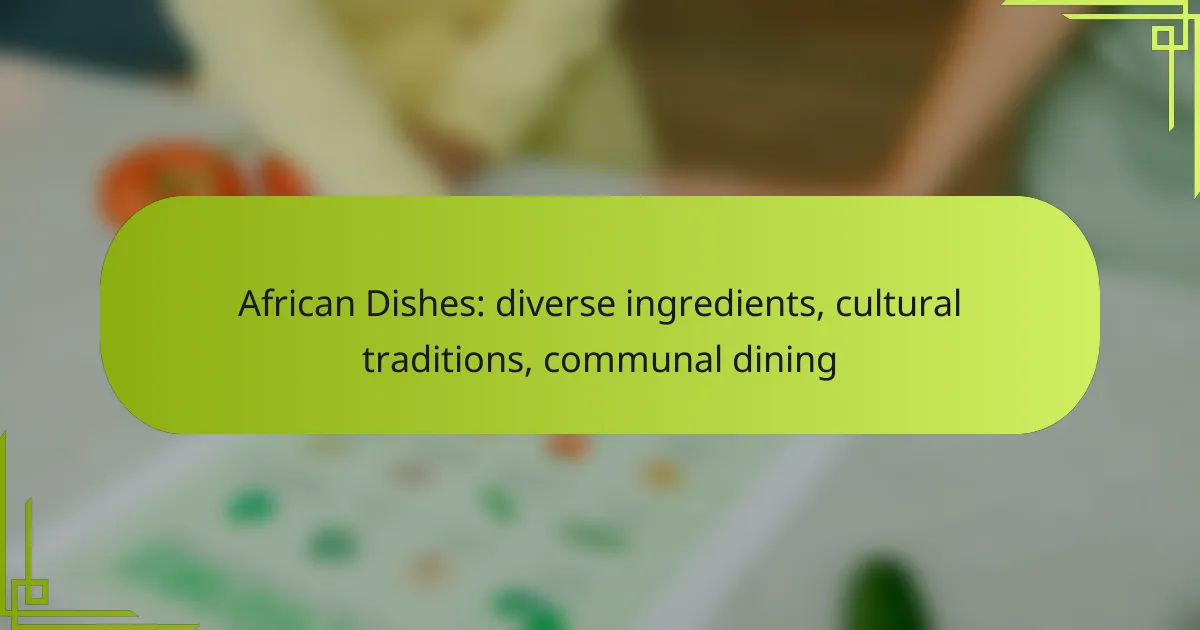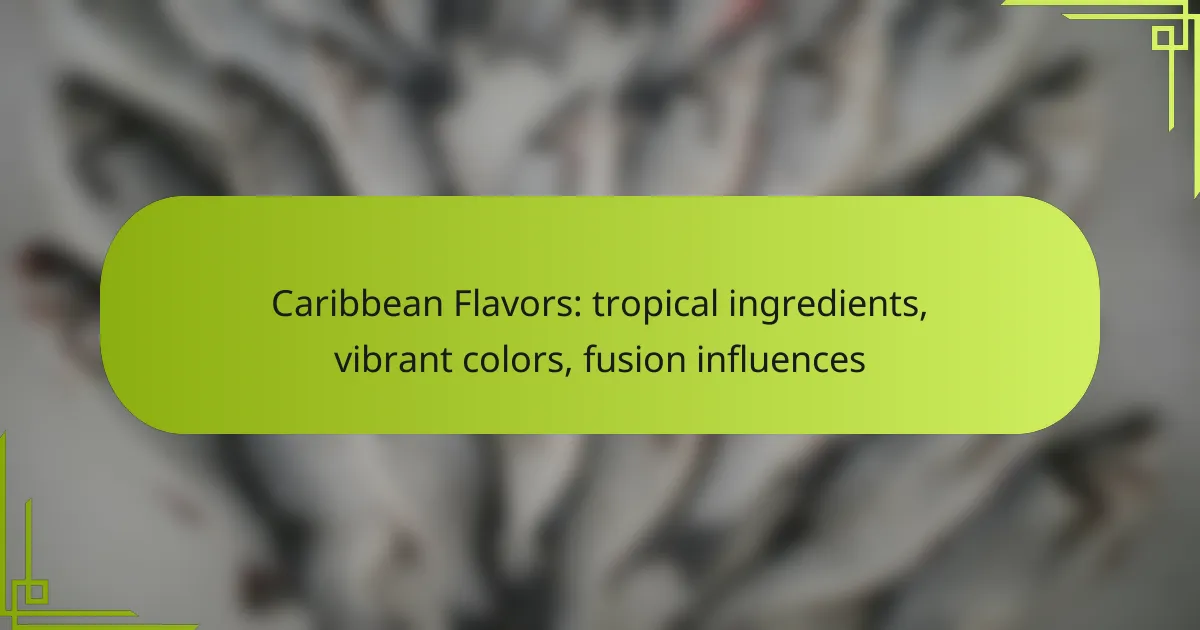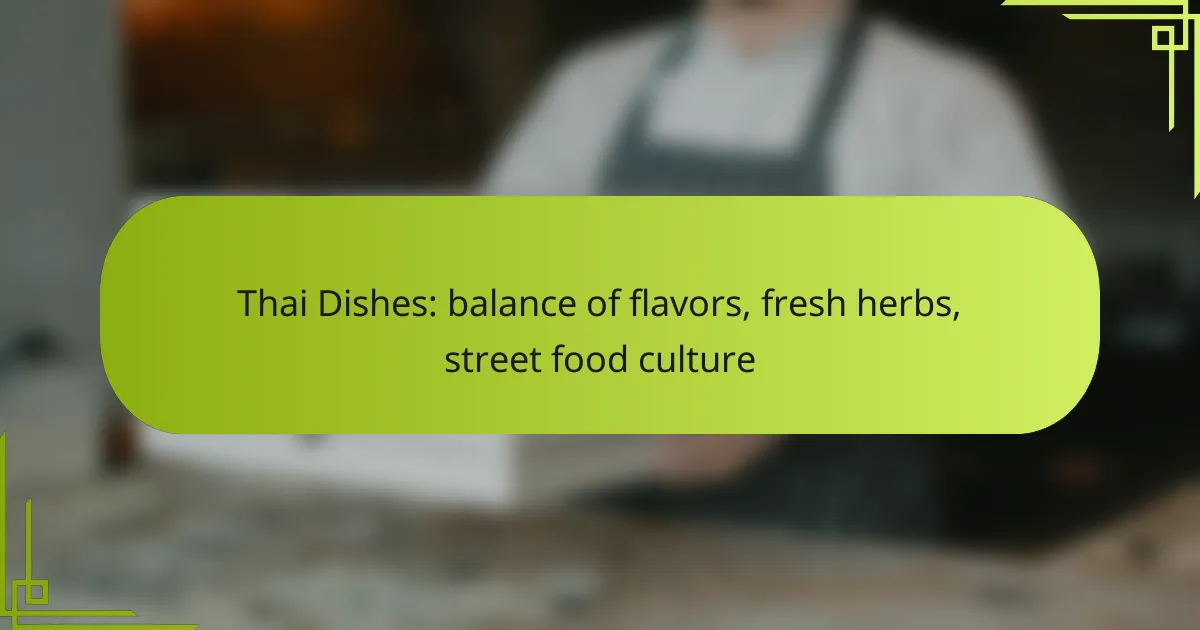Mexican cuisine is renowned for its bold spices, traditional ingredients, and deep cultural heritage. Dishes like tacos, enchiladas, and mole poblano showcase a vibrant array of flavors and cooking techniques that reflect the country’s rich culinary traditions. Emphasizing fresh produce and authentic methods, these meals celebrate the essence of Mexican culture.

What are the most popular Mexican dishes?
Popular Mexican dishes are characterized by bold spices, traditional ingredients, and a rich cultural heritage. Some of the most beloved options include tacos, enchiladas, chiles en nogada, mole poblano, and tamales, each offering unique flavors and preparation methods.
Tacos
Tacos are a quintessential Mexican dish, consisting of a tortilla filled with various ingredients. Common fillings include grilled meats, beans, cheese, and vegetables, often topped with salsa, onions, and cilantro. They can be soft or crispy, and the variety of fillings allows for endless customization.
When enjoying tacos, consider using fresh corn tortillas for the best flavor. Popular types include carne asada (grilled beef), al pastor (marinated pork), and fish tacos, each providing a distinct taste experience.
Enchiladas
Enchiladas are rolled tortillas filled with meat, cheese, or beans, covered with a rich chili sauce. They are typically baked and served with toppings like sour cream, cheese, and avocado. The sauce can vary from mild to spicy, depending on the type of chili used.
For a traditional experience, try enchiladas verdes made with tomatillo sauce or enchiladas rojas featuring red chili sauce. Pair them with rice and beans for a complete meal.
Chiles en nogada
Chiles en nogada is a festive dish that showcases poblano peppers stuffed with a mixture of meat, fruits, and spices, topped with a creamy walnut sauce. This dish is often garnished with pomegranate seeds, adding a vibrant color and sweetness.
Traditionally served during Mexican Independence Day celebrations, chiles en nogada highlight the colors of the Mexican flag. The combination of flavors makes it a unique and celebratory dish.
Mole poblano
Mole poblano is a complex sauce made from a blend of ingredients, including chili peppers, chocolate, spices, and nuts. It is often served over chicken or turkey and is known for its rich, deep flavor profile. The preparation can be labor-intensive, requiring careful balancing of flavors.
When making mole poblano, consider using high-quality chocolate and a variety of dried chiles for depth. This dish is a staple in Mexican cuisine and is often associated with special occasions.
Tamales
Tamales are masa (corn dough) filled with meats, cheeses, or vegetables, wrapped in corn husks, and steamed. They are a traditional food often enjoyed during holidays and celebrations. The fillings can vary widely, allowing for personal preferences.
To make tamales, ensure the masa is well-prepared for the right texture. Popular variations include sweet tamales with cinnamon and raisins or savory ones filled with pork or chicken. Serve them with salsa for added flavor.

How to prepare traditional Mexican dishes?
Preparing traditional Mexican dishes involves using authentic techniques and ingredients that reflect the country’s rich culinary heritage. Focus on bold flavors, fresh produce, and time-honored methods to create meals that celebrate Mexican culture.
Cooking techniques
Common cooking techniques in traditional Mexican cuisine include roasting, frying, and simmering. For example, roasting tomatoes and peppers enhances their flavors, while frying tortillas creates a crispy texture essential for dishes like tacos. Simmering is often used for sauces, allowing spices to meld and develop depth.
Another important technique is the use of a molcajete, a stone mortar and pestle, for grinding spices and making salsas. This method not only preserves the integrity of the ingredients but also adds a rustic touch to the dishes.
Essential ingredients
Key ingredients in traditional Mexican cooking include corn, beans, tomatoes, and various types of chili peppers. Corn is the foundation of many dishes, often used in tortillas or tamales. Beans provide protein and are commonly served as a side or incorporated into main dishes.
Fresh herbs like cilantro and spices such as cumin and oregano are also crucial. These ingredients enhance the flavor profile of dishes and are often used in combination to create authentic tastes.
Spice combinations
Mexican cuisine is known for its vibrant spice combinations that create complex flavors. Common blends include chili powder, garlic, and cumin, which are often used in marinades or to season meats. Another popular combination is the use of oregano and thyme, typically found in salsas and stews.
When preparing traditional dishes, consider balancing heat with sweetness. For instance, pairing spicy chilies with sweet ingredients like pineapple or mango can create a harmonious flavor experience. Experimenting with different combinations will help you discover unique profiles that suit your palate.

Where to find authentic Mexican ingredients in the UK?
To find authentic Mexican ingredients in the UK, explore specialized grocery stores, online retailers, and local markets. These sources offer a variety of traditional items essential for preparing genuine Mexican dishes.
Mexican grocery stores
Mexican grocery stores are the best places to find a wide range of authentic ingredients, from dried chilies to masa harina. Many cities in the UK, especially those with large Hispanic communities, have dedicated shops that stock these essential items.
When visiting a Mexican grocery store, look for brands that are well-known in Mexico. This ensures you are purchasing high-quality products that reflect traditional flavors.
Online retailers
Online retailers provide a convenient option for sourcing Mexican ingredients, especially if local stores are limited. Websites specializing in international foods often carry a comprehensive selection of Mexican staples.
Popular online platforms like Amazon or specialty food websites can offer everything from canned tomatillos to authentic spices. Be sure to check customer reviews to gauge the quality of the products before purchasing.
Local markets
Local markets can be a treasure trove for finding fresh Mexican ingredients. Many farmers’ markets or ethnic food markets feature stalls that sell fresh produce, herbs, and spices commonly used in Mexican cuisine.
When shopping at local markets, engage with vendors to discover unique items and seasonal ingredients. This not only supports local businesses but also enriches your culinary experience with fresh, authentic flavors.

What are the health benefits of traditional Mexican cuisine?
Traditional Mexican cuisine offers numerous health benefits due to its rich use of spices, fresh ingredients, and balanced flavors. These elements contribute to a diet that can support overall well-being and provide essential nutrients.
Nutritional value
Traditional Mexican dishes are often packed with nutrients, including vitamins, minerals, and antioxidants. Ingredients like beans, corn, and a variety of vegetables provide a good source of protein, fiber, and essential nutrients, which can help maintain a healthy diet.
For instance, beans are a staple in Mexican cuisine and are known for their high protein content and fiber, which can aid in digestion and promote heart health. Incorporating a variety of colorful vegetables can further enhance the nutritional profile of meals.
Use of fresh ingredients
Fresh ingredients are a hallmark of traditional Mexican cooking, emphasizing the use of seasonal produce, herbs, and spices. This focus on freshness not only enhances flavor but also maximizes the nutritional benefits of the dishes.
Commonly used fresh ingredients include tomatoes, avocados, cilantro, and peppers, all of which contribute to a vibrant and healthy diet. Choosing locally sourced produce can further support local economies and ensure the highest quality ingredients.
Balanced flavors
The balance of flavors in traditional Mexican cuisine—spicy, sweet, sour, and savory—creates a satisfying and enjoyable eating experience. This variety encourages moderation and can lead to healthier portion sizes, as the complexity of flavors can make meals more fulfilling.
Incorporating spices like cumin, chili, and oregano not only adds depth to dishes but also provides potential health benefits, such as anti-inflammatory properties. Understanding how to balance these flavors can help in creating healthier versions of traditional recipes without sacrificing taste.
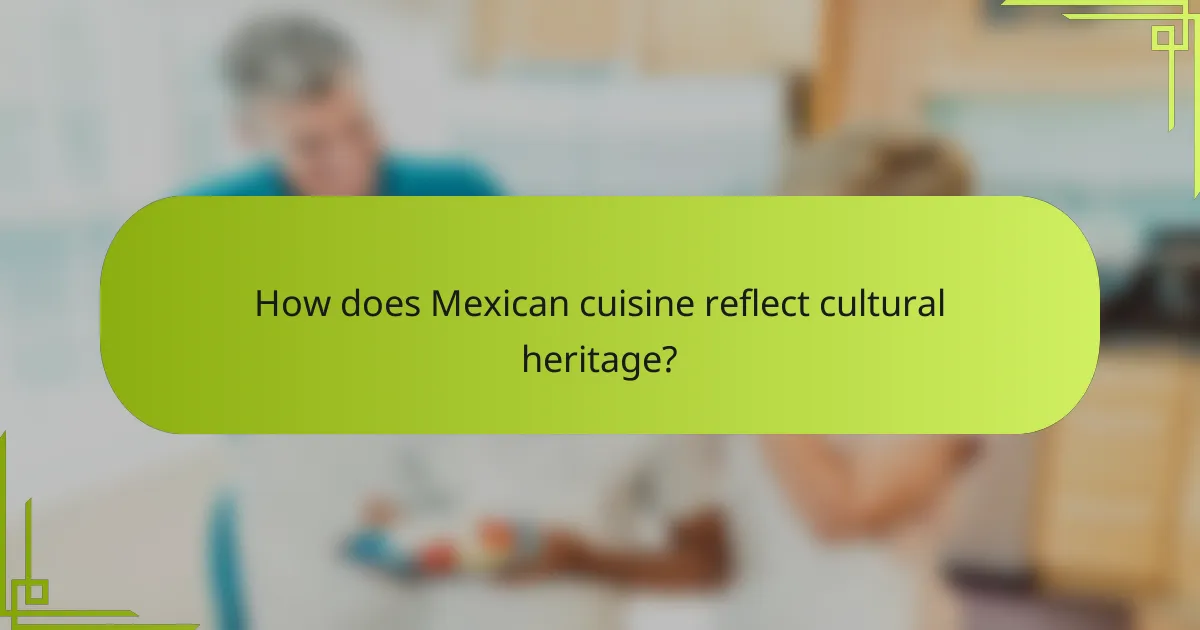
How does Mexican cuisine reflect cultural heritage?
Mexican cuisine is a vibrant tapestry that showcases the country’s rich cultural heritage through its bold spices and traditional ingredients. Each dish tells a story, influenced by indigenous practices, colonial history, and regional diversity.
Traditional Ingredients
Traditional Mexican dishes often feature staple ingredients such as corn, beans, and chili peppers. These elements are not only foundational to the cuisine but also symbolize the agricultural practices of ancient civilizations. For example, corn is used in various forms, from tortillas to tamales, highlighting its significance in daily life.
Other key ingredients include tomatoes, avocados, and various herbs like cilantro. These ingredients contribute to the distinct flavors and textures that characterize Mexican food, making it both diverse and cohesive.
Bold Spices
Spices play a crucial role in defining the flavor profiles of Mexican cuisine. Common spices include cumin, oregano, and cinnamon, which are often used in combination to create complex and rich dishes. The use of spices can vary significantly by region, reflecting local tastes and available resources.
For instance, the Yucatán Peninsula is known for its use of achiote, while the northern regions may favor more robust flavors with the addition of dried chilies. This regional variation showcases the adaptability and creativity inherent in Mexican cooking.
Cultural Significance
Mexican cuisine is deeply intertwined with cultural traditions and celebrations. Many dishes are prepared during specific holidays or family gatherings, reinforcing community bonds and cultural identity. For example, mole is often served during festive occasions, symbolizing hospitality and celebration.
Furthermore, the UNESCO recognition of Mexican cuisine as an Intangible Cultural Heritage of Humanity underscores its importance in preserving cultural practices and promoting culinary diversity. This recognition encourages the continuation of traditional cooking methods and the appreciation of local ingredients.






